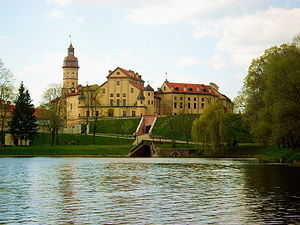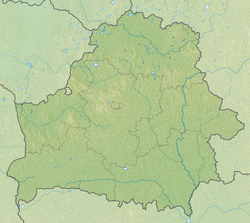Nesvizh Castle
| UNESCO World Heritage Site | |
|---|---|
 View from the lake | |
| Location | Nyasvizh, Minsk Province, Belarus |
| Part of | Architectural, Residential and Cultural Complex of the Radziwill Family at Nesvizh |
| Criteria | Cultural: (ii)(iv)(vi) |
| Reference | 1196 |
| Inscription | 2005 (29th Session) |
| Website | niasvizh |
| Coordinates | 53°13′22″N 26°41′29″E / 53.22278°N 26.69139°E |
Nesvizh Castle or Niasvizh Castle is a castle of the Radziwill family in Nesvizh in Belarus.
History
[change | change source]The estate was owned by the Radziwiłł Belarus magnate family starting in 1533. It was given to Mikołaj Radziwiłł and his brother Jan Radziwiłł after the Kiszka family died. Since the Radziwills were one of the most important and rich clans of the Grand Duchy of Lithuania, it was there that the Lithuanian Archive was moved in 1551. In 1586 the estate was made into an ordynacja.
In 1582 Mikołaj Krzysztof "Sierotka" Radziwiłł started to build a large square three-storey chateau. Building was completed by 1604. They added several galleries half a century later. The château's corners had four octagonal towers.
In 1706, during the Great Northern War, Charles XII's army sacked the castle. The destroyed its fortifications. Several decades later, the Radziwills asked some German and Italian architects to fix and enlarge the chateau. Antoni Zaleski decorated its yellow facades with baroque stucco work. The 16th-century castle gates were also reconstructed. It was at this time that the three separate buildings surrounding the central courtyard were joined into a single structure.
The most important building in Nesvizh is the Corpus Christi Church. It is connected with the castle by a dam over a ditch. It has coffins of 72 members of the Radziwill family, each in a simple coffin made of birch and marked with Trąby Coat of Arms. Designed by the Italian architect Gian Maria Bernardoni, the church is said to be the first Jesuit temple patterned after Il Gesù in Rome. It is the first domed basilica with Baroque facade in the world and the first baroque piece of architecture in Eastern Europe.
In 1770 the castle was taken by Russian forces. The Radziwill family was removed. The Lithuanian Archive was moved to Saint Petersburg (where it remains). The works of art in the palace were given to various Russian nobles. The Russian army left. The palace slowly fell into disrepair. It was restored by the Radziwills. Between 1881 and 1886 the castle's insides were fixed by Prince Anton Radizwill and his French wife, Marie de Castellane. They also made a landscape park in English style. With an area of more than one square kilometre, the park is one of the biggest in Europe.
In 1939, the Radziwill family was removed from the castle by the invading Red Army. In Soviet times, the chateau was used a sanatorium.
In 1994, the castle complex was made a national historical and cultural reserve. Twelve years later, the castle complex was added on the World Heritage List.
Other websites
[change | change source]![]() Media related to Niasviž Castle Complex at Wikimedia Commons
Media related to Niasviž Castle Complex at Wikimedia Commons

